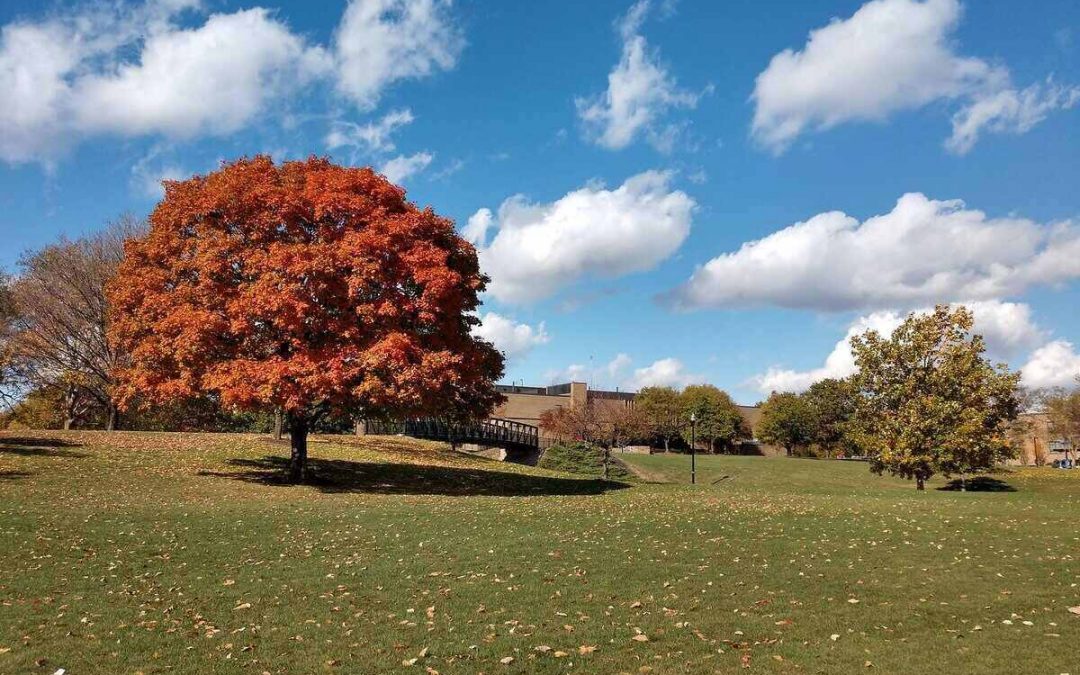If you’re looking for new grass on your capital city lawn, we have four choices for you to consider: Kentucky bluegrass, perennial ryegrass, tall fescue, and fine fescues.
Columbus, Ohio, lawns need cool-season grasses to endure the wide temperature swings throughout the year, but after that, the choice is yours.
Here are some things to consider before grabbing the first bag of cool-season grass you see at the home supply store:
- Level of foot traffic
- Shade vs. sun
- Maintenance
- Drought tolerance
If you like to host get-togethers or flag football games on your lawn, consider a grass with a high foot traffic tolerance. Shade is another big consideration for lawns. If you have partial shade in your lawn, you’ll likely need a mix with sun-shade tolerance.
Which Grass is Best for Your Columbus Lawn?
Let’s take a closer look at each of these four best grass types for Columbus, Ohio, lawns:
1. Kentucky bluegrass
Kentucky bluegrass is a beautiful but high-maintenance lawn. It is often found in a mix with other grass species on this list. It requires full sun and needs regular watering to maintain a healthy, green look.
If you have flower beds that border your lawn, put concrete or metal edging around them. Kentucky bluegrass rhizomes have a reputation for spreading and will tunnel underground to start growing new grass in your flower beds.
Classification: Cool-season
Spreads by: Rhizomes
Shade Tolerance: Low
Drought tolerance: Moderate to High*
Foot traffic tolerance: Moderate, but will recuperate fast due to its network of rhizomes.
Maintenance Needs: High
Mowing Height: 2” – 2 1/2”
Potential for Disease: Moderate to high
Other Notes: Kentucky bluegrass is susceptible to grubs and may be susceptible to thinning in early summer. Too much nitrogen or water leads to a high level of thatch, so annual aeration is sometimes necessary to keep this in check.
* This grass will go dormant if not watered regularly. However, it has an excellent ability to recover from drought. This is due to its network of rhizomes that help it stay alive during drought and recover quickly once watering resumes.
2. Perennial Ryegrass
Perennial ryegrass is often combined with Kentucky bluegrass and has excellent foot traffic tolerance. Like Kentucky bluegrass, it prefers full sun and has a moderate to high maintenance requirement.
Since it has no stolons or rhizomes, perennial ryegrass will not form thatch, which is helpful, especially if it is used in a mix with Kentucky bluegrass. It will develop a deep root system and therefore has a moderate drought tolerance.
Classification: Cool-season
Spreads by: No stolons or rhizomes. Bare patches will need to be re-seeded.
Shade Tolerance: Low – requires sun
Drought tolerance: Moderate
Foot traffic tolerance: High
Maintenance Needs: Moderate to high
Mowing Height: 2” – 3”
Potential for Disease: High
Other Notes: A sharp mower blade is required to cut through perennial ryegrass’s sturdy leaves. Endophyte-enhanced seed may help to reduce insect pressure.
3. Turf-Type Tall Fescue
If you’re looking for a low-maintenance grass with a high foot traffic tolerance, turf-type tall fescue is worth considering. This cool-season grass forms deep roots and can withstand most Ohio droughts with little to no watering.
Use an improved variety of tall fescue for the best results. (Kentucky 31 is not recommended for home lawns.)
Classification: Cool-season
Spreads by: Depends on the variety. Most varieties are bunching. Some varieties have short rhizomes.
Shade Tolerance: Partial shade
Drought tolerance: High
Foot traffic tolerance: High
Maintenance Needs: Low
Mowing Height: 2.5” – 3.5”
Potential for Disease: Low to medium
Other Notes: Use a blend of two or three cultivars if you’re not mixing with another grass species. Excessive water or fertilization can lead to pest and disease issues, but endophyte-enhanced seed can help reduce insect pressure.
4. Fine Fescues
Fine fescues grow well in acidic soil and have a low potential for thatch. Fine fescues also require little nitrogen, which furthers their reputation as a relatively low-maintenance grass. Fine fescues often come in grass mixes with other species, such as Kentucky bluegrass.
Classification: Cool-season
Spreads by: This is a bunching grass — no stolons or rhizomes. Creeping red fescue is an exception and has short rhizomes.
Shade Tolerance: Partial shade
Drought tolerance: High
Foot traffic tolerance: Low
Maintenance Needs: Low to moderate
Mowing Height: 2” – 3”
Potential for Disease: Low to moderate
Other Notes: Consider endophyte-enhanced seed. Endophytes are a type of fungus that repels billbugs, sod webworms, and chinch bugs, reducing insect pressure in the lawn.
Whichever of the four grass types you choose, you should have a green lawn ready for outdoor cookouts, games of flag football, and able to weather the cooler winters common in Columbus, Ohio.
Want a second opinion on the best grass type for your Columbus lawn — or someone to mow your grass? Hire a lawn care pro who can help you choose and install the ideal grass seed for your lawn’s needs or who can keep your yard looking fit and trim.

